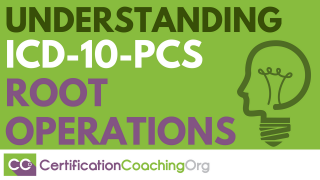Learning the different code sets that we use can be a challenge at first. Yet when the light bulb goes off it becomes captivating. You enter a new world. The International Classification of Diseases, 10th Revision, Procedure Coding System or ICD-10-PCS is unlike any other code set we have seen before.

When you first look at ICD-10-PCS it seems very foreign however once you understand the structure everything falls into place. That new world opens to understanding and a simplicity you will come to enjoy. The click of the light bulb made me think, “Where have you been all my life.” The behemoth of ever-changing procedures in the medical field needs a code set that is adaptable and ICD-10-PCS offers that in spades.
Breaking the Code Set Into Steps
So how do we get to the point of understanding? Breaking the code set into steps is the most effective way to gain the knowledge you need. Think of ICD-10-PCS as a train with linking boxcars. In each car you find the content to get to the highest specificity. Each boxcar fills in a blank and adds to the description of the trains’ path.
Consider the first character in ICD-10-PCS as the engine. Where is the journey taking you? There are seventeen choices like; 1 – Obstetrics, 4 – Measurement and Monitoring and G – Mental Health. The most common character will be 0 – Medical and Surgical. For an example start in Medical and Surgical.
After you have picked where the engine will take you we start adding cars. The body system we are working on gives us the next step. These are very easy to pick out of the thirty-one choices as the body systems are clearly defined. It is the third car that usually stops people in their tracks.
Picking the Root Operation
In the third car, we need to pick the root operation. Unlike with CPT which is based on what you are doing to the patient in ICD-10-PCS, the focus is the outcome of the procedure. Another difference in this area that you will note is the thirty-one characters are not in numerical consecutive order and there are more letters then numerical characters. Don’t let this alarm you. There is no need to memorize these characters. They will always be at your fingertips via your manual or an encoder.
During your study of ICD-10-PCS, the root operation will most likely be the main area to get you flustered. It is here you may find terms you are not as familiar with like extirpation. The latter is the process of taking or cutting out solid matter from the body part. Key to remember, solid matter. Often confusion with extirpation is made when dealing with fluids and gases versus a solid matter. In the case of fluids or gases, the root operation is drainage, not extirpation. An example of an extirpation code could be OBCC0ZZ – Extirpation of Matter from Right Upper Lung Lobe, Open Approach. A drainage code would be 0B9C00Z – Drainage of Right Upper Lung Lobe with Drainage Device, Open Approach.
One of the reasons that ICD-10-PCS gives us a higher specificity from its predecessor is that both of these codes for an extirpation or drainage would have been the same code in ICD-9 as 33.1 – Incision of the lung. The diversity with which ICD-10-PCS allows leaves little room for guesswork. Thus simplifying the learning of the code set.
Determining the Outcome
Now you know where the train is going, medical-surgical, and the body system you are working in, respiratory system, you only need to determine what the outcome is. After that, it is a matter of filling in the blanks from a drop-down choice list. Which approach is being taken, open, percutaneous, percutaneous endoscopic, via natural or artificial opening or via natural or artificial opening endoscopic being the most common choices. This is followed up by the device if any is being used. If you are dealing with biopsies then you will use a qualifier in the last character. Otherwise, this is left to the character of Z for no qualifier.
There are seven characters in an ICD-10-PCS code. It is an alphanumeric code system which can have up to thirty-four choices or values. Again, do not worry about memorizing these characters as some change with each body system. Laterality still applies which is one of the reasons you will find so many values. By giving you more choices it, in turn, simplifies the process.
Embrace the new world of ICD-10-PCS and relish what it can do for you. Give it a little time, study the terminology of root operations and the rest will fall into place. Remember why you code. We code for statistical purposes. With this knowledge, we can tell how often an I&D of the lung results in positive outcomes with a given diagnosis. Having the ability to be as specific as ICD-10-PCS allows guidelines and regulations for procedures can be set. This, in turn, provides for better outcomes in our patient care and saves money. As a coding leader, you are an integral part of the process.
If you need help learning ICD-10-PCS, visit our ICD-10-PCS Course.
![[CCO] Certification Coaching Organization LLC [CCO] Certification Coaching Organization LLC](https://www.cco.us/wp-content/uploads/2015/05/CCO-Logo-2015-d3-500px.png)